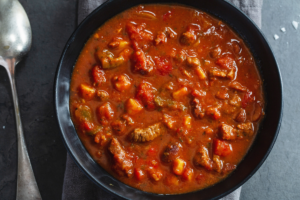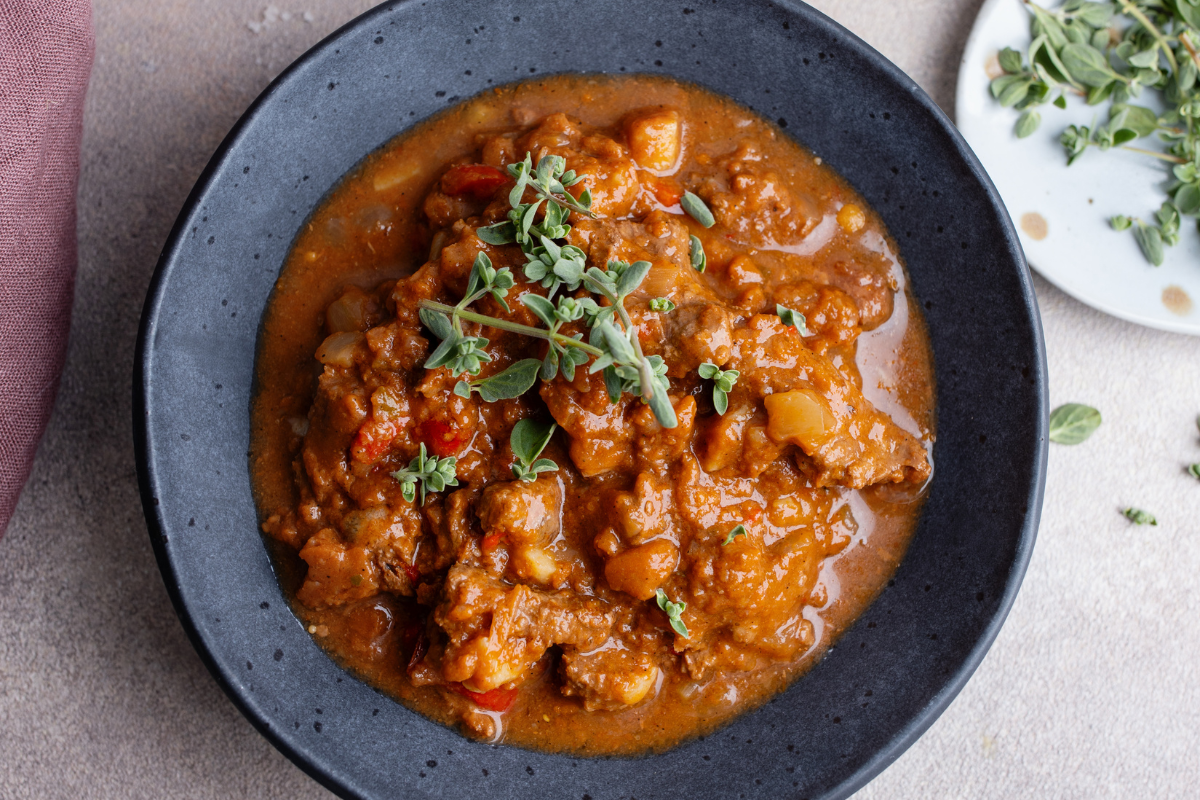Goulash recipe, a dish with origins deeply rooted in Central European culinary traditions, has become a beloved comfort food across the globe. Its evolution from a simple Hungarian dish to a staple in American households highlights its versatility and widespread appeal. Understanding the difference between American and Hungarian Goulash is essential to fully appreciate the various interpretations of this hearty meal.
The Origins of Goulash Recipe: From Hungary to the World
Hungarian cooks originally prepared goulash in Hungary as a simple, nourishing meal for herdsmen. Known as “gulyás” in Hungarian, this dish was initially a thick soup made with meat and vegetables, seasoned with a generous amount of paprika, the hallmark of Hungarian cuisine. Over time, goulash has transcended its humble beginnings, becoming a beloved dish in many countries, each putting its unique spin on the recipe.
Hungarian Goulash Recipe: A Rich Tradition
Hungarian Goulash is characterized by its rich, flavorful broth, which is heavily infused with paprika. The dish typically includes chunks of beef, onions, garlic, and bell peppers, all simmered together in a broth seasoned with paprika, caraway seeds, and marjoram. The result is a stew-like consistency that is both warming and satisfying, making it a perfect comfort food for cold weather.
The key to an authentic Hungarian Goulash lies in the quality of the paprika used. Hungarian paprika is renowned for its deep, sweet flavor and vibrant color. When selecting paprika for your goulash recipe, it’s important to choose the right variety—whether sweet, hot, or smoked—to achieve the desired flavor profile. For those looking to explore the authentic flavors of Hungarian cuisine, the Hungarian Paprika Guide is an invaluable resource for selecting the best spices for your recipe.
American Goulash Recipe: A Simplified, One-Pot Wonder
In contrast to its Hungarian counterpart, American Goulash is a simpler, one-pot dish that is quicker and easier to prepare. Also known as “Slumgullion” in some regions, American Goulash typically features ground beef, elbow macaroni, and a tomato-based sauce. It’s a dish that many Americans grew up eating, often prepared by their parents or grandparents for a quick and filling weeknight meal.
The American version of goulash is less about the rich, complex flavors found in Hungarian Goulash and more about convenience and comfort. It’s a dish that can be made in large batches, making it ideal for feeding a crowd or for meal prepping. Despite its simplicity, American Goulash is equally hearty and satisfying, offering a different yet equally beloved take on this classic dish.
Essential Ingredients for Goulash Recipe

Whether you’re making Hungarian Goulash or American Goulash, the key to success lies in selecting the right ingredients. Here’s a breakdown of the essential components for a delicious goulash:
- Meat: For Hungarian Goulash, beef chuck is the traditional choice, as it holds up well during long cooking times, becoming tender and flavorful. For American Goulash, ground beef is commonly used for a quicker, easier preparation.
- Vegetables: Onions and garlic are essential for both versions, providing a base of flavor. Hungarian Goulash often includes bell peppers and tomatoes, while American Goulash may also include additional vegetables like celery or carrots.
- Spices: Paprika is the star of the show in Hungarian Goulash, with sweet or hot varieties depending on your taste. Other spices like garlic powder, caraway seeds, and marjoram are also common. American Goulash typically uses Italian seasoning, garlic powder, and paprika for a milder flavor profile.
- Tomato Base: Both versions use a tomato base, but the approach differs. Hungarian Goulash uses fresh or canned tomatoes, sometimes with tomato paste, to create a rich, tangy broth. American Goulash often relies on tomato sauce and diced tomatoes, providing a thicker, more robust sauce.
- Pasta: Elbow macaroni is the classic choice for American Goulash, but feel free to experiment with other pasta shapes. Hungarian Goulash is traditionally served with noodles, dumplings, or crusty bread rather than incorporating pasta directly into the dish.
To ensure your pasta is perfectly cooked and doesn’t turn mushy in your goulash recipe, it’s important to follow a good pasta cooking guide. Cooking the pasta separately and adding it to the sauce just before serving can help maintain the desired texture.
Step-by-Step Preparation of Goulash
Making goulash, whether Hungarian or American, is a straightforward process that even novice cooks can master. Here’s a step-by-step guide to help you prepare this comforting dish:
- Prepare the Meat: For Hungarian Goulash, start by browning beef chuck in a large pot, ensuring it’s well-seasoned with salt and pepper. For American Goulash, brown the ground beef, breaking it up as it cooks. Drain any excess fat before proceeding.
- Cook the Vegetables: Add chopped onions, garlic, and bell peppers to the pot. Sauté until softened and fragrant. In Hungarian Goulash, the vegetables should be cooked slowly to allow their flavors to meld with the beef.
- Create the Sauce: For Hungarian Goulash, add your tomato base—fresh or canned tomatoes, and a bit of tomato paste—along with the paprika and other spices. For American Goulash, add tomato sauce, diced tomatoes, and Italian seasoning. Let the mixture simmer for at least 20 minutes to develop its flavors.
- Cook the Pasta: While the sauce simmers, cook your pasta until al dente. It’s important not to overcook the pasta, as it will continue to cook slightly when mixed with the sauce.
- Combine and Simmer: For Hungarian Goulash, you should serve the stew over cooked noodles or, alternatively, with a side of crusty bread. On the other hand, you should mix the cooked pasta directly into the sauce for American Goulash, ensuring you thoroughly coat every piece. Then, simmer it for a few minutes to allow the flavors to meld together.
For a delicious twist on traditional goulash, consider using slow-cooked beef chuck instead of ground beef in your American Goulash. This method, detailed in a comprehensive guide to beef chuck roast, results in a richer, more flavorful dish.
Popular Variations of Goulash
Goulash is a versatile dish, and there are many variations to suit different tastes and dietary needs. Here are some of the most popular:
- Hungarian Goulash: This version incorporates chunks of beef and a more broth-like consistency, making it closer to a stew. People typically serve it with noodles or bread and recognize it for its deep, rich flavor.
- American Goulash: A one-pot dish that’s quicker and easier to prepare, often featuring ground beef, elbow macaroni, and a tomato-based sauce. It’s a staple of American home cooking, beloved for its simplicity and heartiness.
- Vegetarian Goulash: For a plant-based version, substitute meat with lentils, beans, or mushrooms. The result is a hearty, satisfying dish that retains the rich flavors of traditional goulash without the meat.
- Slow Cooker Goulash: Perfect for busy days, this version allows the flavors to develop over time as the dish cooks slowly in a crockpot. It’s an easy, hands-off way to prepare a comforting meal.
Each of these variations offers a unique take on the classic dish, showcasing its adaptability to different preferences and dietary requirements.
Tips and Tricks for the Best Goulash
To ensure your goulash recipe turns out perfectly every time, here are some tips and tricks:
- Avoid Mushy Pasta: Cook your pasta separately and add it to the sauce just before serving. This helps prevent the pasta from becoming mushy and ensures it maintains a pleasant texture.
- Achieve the Perfect Spice Balance: Taste as you go and adjust the seasonings gradually. It’s easier to add more spices than to take them away, so start with a small amount and build up to your desired flavor.
- Make It Ahead: Goulash often tastes even better the next day, as the flavors have time to meld and develop. Consider making it in advance and reheating it when you’re ready to serve.
For additional tips, especially on handling pasta, you can check out guides on how to keep pasta from sticking together. This can help ensure your goulash is perfect every time.
Serving Suggestions for Goulash
Goulash is a versatile dish that pairs well with various sides, making it a complete meal:
- Serve with: Crusty bread is a classic accompaniment, perfect for soaking up the rich sauce. A simple green salad can add a fresh contrast to the hearty goulash, and pickles can provide a tangy bite that complements the dish.
- Garnish with: Fresh parsley adds a pop of color and a hint of freshness. A dollop of sour cream can add richness and creaminess, while shredded cheese can provide an extra layer of flavor and indulgence.
Storing and Reheating Goulash
One of the great things about goulash is how well it stores, making it ideal for meal prep or leftovers:
- Storing: Place leftovers in an airtight container and refrigerate for up to three days. The flavors will continue to develop, making the dish even more delicious when reheated.
- Reheating: Warm the goulash gently on the stove or in the microwave. If the sauce has thickened too much, add a splash of water or broth to loosen it up.
FAQs
- Can Goulash be frozen? Yes, goulash freezes well. Just be sure to cool it completely before freezing. Thaw it in the refrigerator before reheating to preserve the texture and flavor.
- What’s the difference between Goulash and spaghetti? While both dishes use pasta and a tomato-based sauce, goulash incorporates more spices and often includes additional vegetables, making it a more complex dish in terms of flavor.
- How can I make Goulash gluten-free? Simply use gluten-free pasta and ensure all other ingredients are free from gluten. Many gluten-free options are available that can easily replace traditional ingredients.
- What’s the origin of Goulash? Goulash originated in Hungary as a simple, nourishing dish for herdsmen. Over time, it has evolved and spread to other countries, becoming a staple in many cuisines.
Conclusion: The Versatility of Goulash
Whether you’re new to cooking or a seasoned chef, goulash is a versatile dish that everyone can enjoy. Its rich flavors and hearty ingredients make it the perfect meal for any occasion. Don’t hesitate to try different variations and make this recipe your own. With its deep roots in Central European culinary traditions and its wide appeal, goulash is a dish that continues to bring comfort and satisfaction to tables around the world.
For more inspiration and recipes, check out our comprehensive guides to beef chuck roast or ground beef, which can help you elevate your culinary skills and create even more delicious meals.

